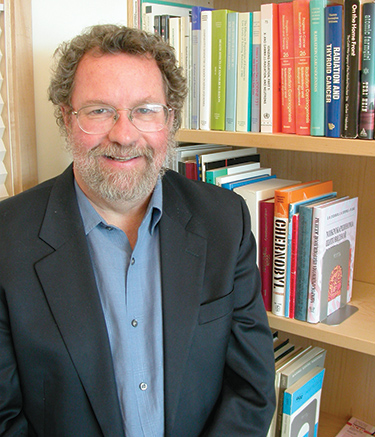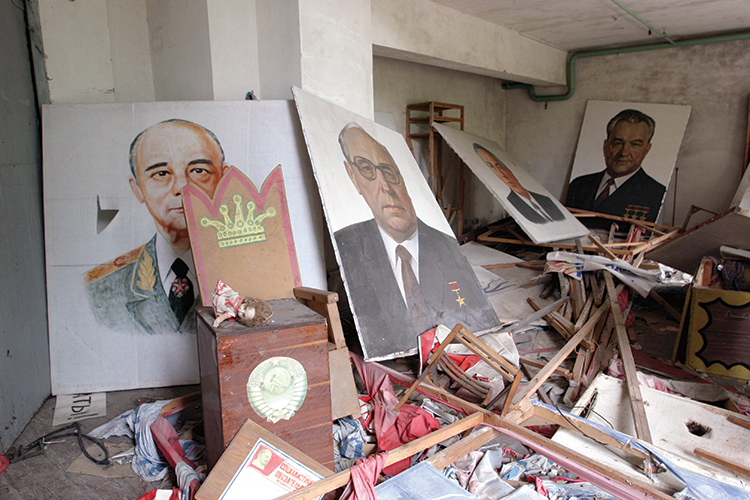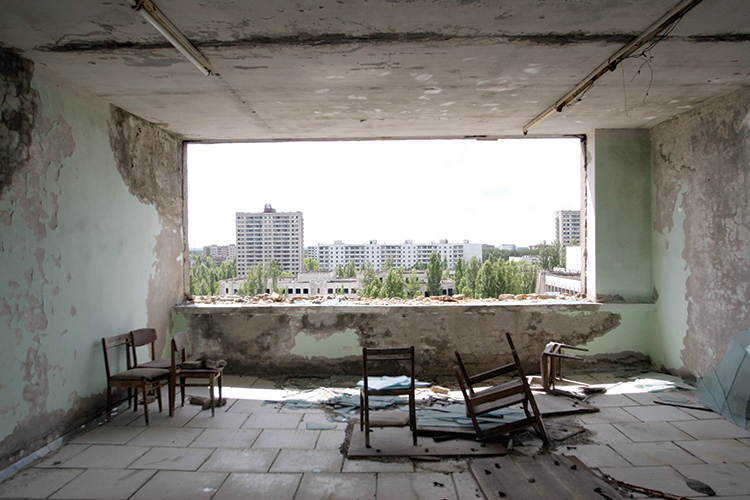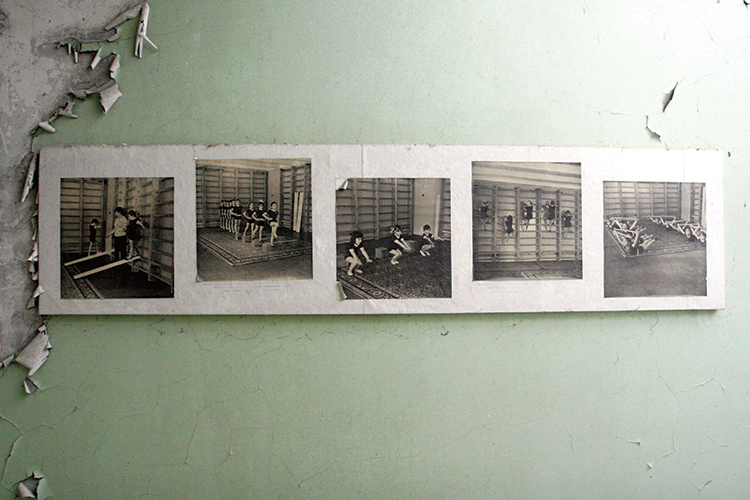The roof weighed 1,000 tons, but the blast blew it to pieces. Inside the building, a raging inferno drove temperatures to a hellish 2,000 degrees centigrade. Above, a plume of radiation – 100 times stronger than the poison spewed by the two atomic bombs dropped on Japan – wafted over cities, villages and fields.
Suddenly, Chernobyl was no longer an unknown city of 10,000 people somewhere behind the Iron Curtain. It was a metaphor for hell on earth—and a chilling lesson in what might be expected if a similar nuclear mishap or act of terrorism ever occurs elsewhere.
Thirty-one people died immediately after the chemical explosion at the Chernobyl nuclear power station in the early morning of April 26, 1986. Authorities estimate another 25,000 “liquidators” — soldiers and firefighters involved in cleanup operations — have also died from exposure to the plant’s radiation. The disaster uprooted more than 400,000 people and turned Chernobyl and hundreds of surrounding villages into ghost towns.

UW Epidemiology Chair and Fred Hutchinson Cancer Research Center Scientist Scott Davis, ’80
While the world has long known what triggered the disaster—a sudden power surge during a test of the electrical system—the question now is how many more deaths and illnesses will history lay at Chernobyl’s doorstep, and what can be learned from them.
After more than 40 trips to Russia, Scott Davis, ’80, has accumulated a number of curious souvenirs.
Many of them sit on a shelf in his office at the Fred Hutchinson Cancer Research Center, where Davis, chair of the epidemiology department at the University of Washington, is an investigator. The mementoes range from a wooden comb bearing the inscription “From Siberia With Love” to a bright red pennant with a picture of Lenin on it.
One item, however, is more than a souvenir. It’s a testament to the lasting contribution Davis is making as the leader of an international research team investigating the aftermath of the Chernobyl disaster. A diploma, written in the Cyrillic alphabet, proclaims Davis a member of the Russian Academy of Medical Sciences—an honor never before bestowed on a foreign epidemiologist.
Awarded last year, the diploma acknowledges 15-plus years of research exploring the link between the release of radiation from Chernobyl’s ravaged reactor number four and outbreaks of thyroid cancer in the surrounding population.
The significance—and difficulty—of that work is hard to overstate. Without the determination of Davis and his colleagues – including persisting through the collapse of the Soviet Union – the rare opportunity presented by the Chernobyl disaster to study the long-term effects of radiation exposure on a large population would have been lost.

A storage room in a theater in Prypiat, about five miles from Chernobyl, is still full of abandoned props almost 20 years after the disaster.
“None of it would have happened,” says Davis. “There have been numerous attempts to ‘study’ Chernobyl. There have been hundreds of papers published. But there have been very, very few serious efforts to configure and conduct high-quality epidemiological studies of the health impact of Chernobyl radiation exposure.”
For all of the former Soviet Union’s prowess in many fields of science, it never emphasized epidemiology—the study of the causes of diseases in populations—says Davis. And that left the Soviets unable to conduct the type of research necessary to track Chernobyl’s long-term impact on the health of the surrounding population. “They basically had no experience or expertise in conducting an epidemiological study,” says Davis. “They had no infrastructure to do so. They had no resources in terms of money to do so.”
Finally, in early 1990, foreign epidemiologists, most notably Davis and colleagues from “the Hutch,” won the Soviet Union’s approval to collaborate with its scientists to organize modern epidemiological studies – and along the way build lasting trust, respect and friendship between scientists from rival superpowers.
“That, besides actually getting some epidemiology done, is one of the best things we’ve been able to accomplish,” says Ken Kopecky, a biostatistician at the Hutch and affiliate professor of biostatistics at the UW, who has worked side by side with Davis from the beginning. “There were a lot of barriers to overcome. Scott’s ability to keep this all going … is a tribute to his drive and adaptability.”
So far, Davis and his collaborators have definitively linked radiation from Chernobyl to an ongoing outbreak of thyroid cancer among people who were exposed as children, primarily by consuming contaminated dairy products but also through external exposure. More importantly, for the first time they have determined the doses most likely to lead to thyroid cancer. Ahead lies a study of thyroid cancer in people who were exposed as adults and a search for the genetic signature of radiation-associated thyroid cancer.
Anywhere from 5 to 8 million people have been exposed – and some of them remain exposed—to potentially dangerous levels of radiation from Chernobyl. Estimates of the number of people who will ultimately develop thyroid cancer as a result of the disaster vary. According to Chernobyl.info, a United Nations-sponsored Web site, at least 1,800 children and adolescents exposed to fallout from Chernobyl contracted the disease—which normally strikes only adults. Meanwhile, various sources predict anywhere from 8,000 to 50,000 to 100,000 people ultimately will develop the disease, which generally is not fatal if detected and treated, as the years go by.
“Projecting the number of expected thyroid cancers is very difficult to do because of the uncertainties regarding doses and number of people exposed and the risk associated with radiation dose – a long way of saying we really don’t have answers,” notes Davis. Even so, knowing there is a definite link between Chernobyl and thyroid cancer will help authorities anticipate future, if as-yet-undetermined, demands for care.

Ruins of the Hotel Polisia as it looks today in Prypiat.
Increases in all sorts of other medical problems – everything from leukemia to stomach cancer to birth defects – have also been reported. Davis and his team hope soon to explore Chernobyl’s link to breast cancer. So far, however, an increase in thyroid cancer is the only scientifically proven health consequence of the disaster. “No other health effects have been consistently or convincingly linked to Chernobyl,” says Davis.
Thyroid cancer is a relatively rare disease, accounting for only 1 percent of all cancers. According to the American Cancer Society, 25,690 new cases of thyroid cancer will be diagnosed in the U.S. this year. Although an estimated 1,490 Americans will die of thyroid cancer in 2005, most forms of the disease are highly treatable.
Today, reactor number four is entombed within a steel and concrete sarcophagus surrounded by two exclusion zones—a 10-kilometer zone that requires special permission to enter and a 30-kilometer zone in which nobody is supposed to live, although some still do. “Everything looks normal, but there’s nobody there,” says Davis. “Towns and villages and houses and all vestiges of life are just abandoned. You think, ‘What if something like this happened in the United States?’ Can you imagine that?”
As chair of the UW Department of Epidemiology, Davis leads one of the top programs in the country. He also graduated from the unit, earning his doctorate in 1980. “My time there shaped my interest in radiation epidemiology and really launched my career,” he says, citing professors Robert Day, David Thomas and Noel Weiss as mentors.
Much of what scientists know about the health effects of radiation exposure is a byproduct of two horrific events. One is the explosion at Chernobyl. The other is the bombing of Hiroshima and Nagasaki. As a freshly minted UW assistant professor, Davis traveled to Hiroshima to work as a research associate at the Radiation Effects Research Foundation. The foundation has been tracking bombing survivors for years and is “the most comprehensive and probably the most important source of information we have about the effects of radiation in humans,” Davis says.
Davis did not set out to focus his career on radiation, but his stint at the foundation from 1983 to 1985 made a deep impression. “Just being in the cities … and then being part of the effort to describe and document what has happened to the people that survived is a very sobering experience and pretty compelling in terms of doing something that’s meaningful,” he says. “The image that immediately comes to mind is my first visit to the A-bomb museum and peace park – the pictures and displays were very sobering and being there among all the Japanese citizens and school children made it a difficult experience.”
Davis had been back from Japan for less than a year when Chernobyl blew. He and Kopecky soon realized the scientific opportunity the disaster presented and the importance of setting up studies there right away. Try as they might, however, they were “pretty much shut down” as Cold War tension between the U.S. and Soviet Union proved insurmountable. “It’s really unfortunate,” says Davis. “If you could get in there at the time and measure radiation, both in the environment and in the people themselves, that’s obviously far better than trying to reconstruct it several years after the fact.
Ultimately, serendipity opened the door. In 1990, a Russian helicopter pilot involved in the initial efforts to contain the radiation at Chernobyl came to Fred Hutchinson for a bone-marrow transplant. That led to an informal exchange program between the Hutch, led by then-President Robert Day, and the National Center for Hematology in Moscow.

Photos left on a wall in an abandoned nursery school.
Davis and Kopecky made their first trip to Moscow that year and quickly began laying the groundwork for their research. One year later, however, the Soviet Union collapsed. Many observers believe Chernobyl played a significant role in the breakup due to the government’s lack of candor – it did not even acknowledge the explosion for nearly three days – and the disaster’s enormous drain on the economy: an estimated $235 billion in Belarus alone over a 30-year period.
For Davis, the collapse meant renegotiating with three new governments – Ukraine, where Chernobyl is located, and neighboring Belarus and Russia. Sailing to the rescue was Admiral Elmo Zumwalt. A trustee at Fred Hutchinson and former chief of naval operations for the U.S. Navy, Zumwalt used his connections to help the Hutch establish new relationships with the three countries. With funding from the Office of Naval Research, the groups formed the International Consortium for Health Effects of Radiation.
Political hurdles aren’t the only obstacles that Davis and his colleagues have had to overcome. They’ve also had to go backwards in time, determining radiation exposure levels based on limited data collected by the Soviets immediately after the disaster and on interviews with current survivors.
“The basic idea,” says Davis, “is that you try to assemble as much information as you can about how much radiation was released, what types of radiation were released, and then develop [computer] models to account for how it was dispersed through the air, deposited on the ground, taken up by vegetation into the food chain – and then eventually how consumption of contaminated milk and food and water would translate into radiation doses in an individual.”
One particular type of radiation – a radioactive form of iodine known as iodine-131 – is the focal point of the Davis team’s research. Unlike other Chernobyl fallout components such as caesium-137, strontium-90 and plutonium, which remain at alarming levels to this day depending on their relationship to fallout patterns, iodine-131 decays rapidly and no longer poses an active threat. Tragically, though, in the days and weeks following the explosion, concentrated amounts of iodine-131 accumulated in the milk of cows grazing in poisoned pastures. And when people consumed dairy products derived from that milk, their thyroid glands, which absorb iodine, soaked up cancer-causing doses of radiation.
The first sign of iodine-131’s insidious impact came soon after the disaster, when numerous cases of thyroid cancer – which normally occurs only in adults – began showing up among children in the area where the fallout settled. Later, adults who were exposed as children also started developing thyroid cancer in disproportionate numbers. Now, Davis and his team have provided evidence of what many suspected – that Chernobyl spread thyroid cancer – and have generated new information about radiation dosages and risk.
In a world where nuclear power remains an important energy option and where nuclear terrorism is a very real threat, collecting such information is more than an academic exercise. “Unfortunately, I believe it is pretty likely that another incident will occur,” says Davis. “Knowing as much as we can regarding the effects of radiation exposures at different levels and who is likely to be at highest risk will hopefully better prepare us for responding to such an event.”
A curable cancer, if caught in time
What Scott Davis has learned in Russia — that people exposed to radiation from Chernobyl as children are at greater risk of developing thyroid cancer depending upon their level of exposure — is significant but not entirely surprising.
Previous studies in the U.S. have shown that a history of head or neck radiation treatments in childhood—a not uncommon therapy for certain conditions in the 1950s—represents a major risk. While thyroid cancer rarely occurs during childhood, children are more vulnerable to the long-term effects of radiation than adults and are prone to develop thyroid cancer later in life if exposed at an early age. Other risk factors include a diet low in iodine and certain inherited conditions.
Although the late Supreme Court Chief Justice William Rehnquist’s case made headlines, thyroid cancer is a relatively rare disease, accounting for only 1 percent of all cancers. According to the American Cancer Society, 25,690 new cases of thyroid cancer will be diagnosed in the U.S. this year. Although an estimated 1,490 Americans will die of thyroid cancer in 2005, most forms of the disease are highly treatable through a combination of surgery, radioactive iodine treatment, thyroid hormone therapy, external beam radiation therapy and chemotherapy.
The thyroid gland is a butterfly-shaped gland located in the front of the neck. The gland takes up iodine from the diet and the blood and makes a hormone important for many bodily functions. Symptoms of thyroid cancer include swelling, hoarseness, difficulty swallowing and coughing accompanied by bleeding.